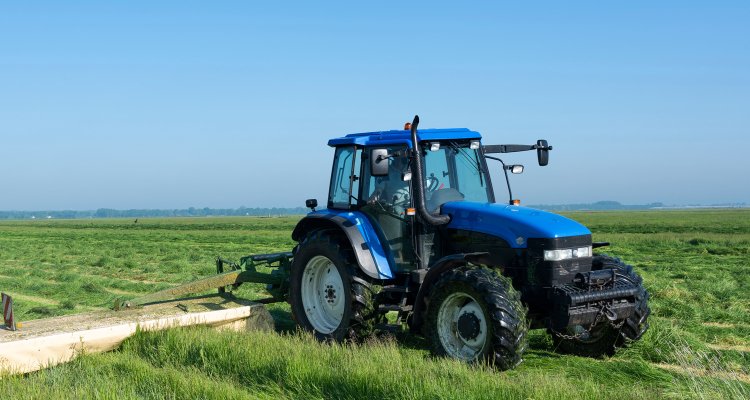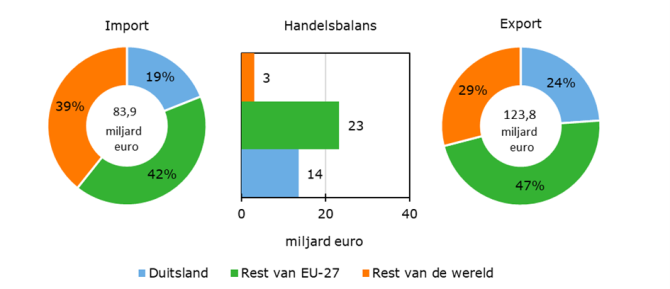
News
Lower export volume and higher prices lead to limited agricultural export growth
Dutch exports of agricultural goods (primary, unprocessed goods and secondary, processed goods) are estimated at 123.8 billion euros in 2023 (Figure 1),which is a limited growth (1.6%) compared to 2022. Dutch agricultural imports decreased by 3.3% in 2023, to 83.9 billion euros (Figure 1).
The slightly increased export value in 2023 is the result of a lower export volume, but a stronger increase in export prices. The import volume has also decreased, a decrease which is stronger than the price increase. This is reported by Wageningen Economic Research (WUR) and Statistics Netherlands (CBS) based on joint research commissioned by the Ministry of Agriculture, Nature and Food Quality (LNV).

Homegrown agricultural exports increased
The Netherlands' export value can be divided into Dutch-made goods (82.1 billion euros) and re-exports of foreign-made agricultural goods (41.7 billion euros). Approximately two-thirds of agricultural goods exports, then, are Dutch-made. Dutch-made exports increased by 3.6% in value, while re-exports decreased by 2%. Goods of Dutch manufacture are "homegrown" or are products that have been significantly processed after import. Consequently, this figure is also an indication of the importance of the food industry in the Netherlands. Re-exports are unprocessed or lightly processed imports that pass through the Netherlands to a third country and mainly give insight into the role the Netherlands plays in storing goods, collecting, and in ‘just in time’ deliveries.
In total goods exports, 52% were Dutch-made and 48% re-exports were foreign-made. The trade surplus (export-import value) of Dutch agricultural goods amounted to 39.9 billion euros. Most agricultural exports in 2023, as in previous years, go to our neighboring countries. Of the estimated total exports, almost a quarter will go to Germany. Belgium is in second place with 12%. Next as main customers are France (9%) and the United Kingdom (8%). In 2023, 71% of the total export value went to EU-27 countries.
Dairy and eggs main export products
Dairy and eggs (€12 billion), ornamental plant products (€11.5 billion), meat (€11.2 billion), potatoes and vegetables (€8.7 billion) and beverages (€8.1 billion) are the top commodity groups in exports. The top five account for nearly 42% of the total export value in agricultural goods in 2023.
Neighbouring countries important for imports
Measured by value, 60.7% of what the Netherlands imports, comes from EU-27 countries. As with exports, neighboring countries are the most important. These are Germany (19% share), Belgium (almost 14%) and France (6%). China has become less important as a supplier of agricultural products: its import value decreased by 24%.
Natural fats and oils comprise the largest share of the Netherlands’ imports 7.8 billion euros) in 2023, fruit follows with (7.6 billion euros). This is followed by beverages (5.9 billion euros), other agricultural goods such as glycerol, rubber, wood, fatty acids (5.8 billion euros) and dairy and eggs (5.7 billion euros). Together, these five product groups account for 39% of the total import value of agricultural goods.
Export value of agriculture-related goods declines
For 2023, exports of agriculture-related goods (or tertiary agricultural exports) are estimated at €12.0 billion, down 7% from 2022 (€12.9 billion). This decrease is due to a sharp decline in the export value of fertilisers. In particular, the price of fertilisers has fallen. Without these fertilisers as part of agriculture-related goods, the export value for this group of products would have increased by 6%. Therefore, exports to Belgium (-24%) and France (-18%) decreased sharply. Imports of agriculture-related goods are also estimated at €5.7 billion in 2023, 7% lower than in 2022.
Notes: agricultural exports
Wageningen University & Research, CBS and the Ministry of Agriculture, Nature and Food Quality (LNV) have determined, in line with international classifications, which goods do and do not fall within the definition of agricultural goods. Agricultural goods trade refers to the first 24 chapters of international trade statistics plus a number of agricultural goods from other chapters according to the Combined Nomenclature coding system (CN). Agricultural goods include both unprocessed (primary) agricultural products such as pigs, apples, flowers, flower bulbs and tomatoes, and processed (secondary) products such as cheese, French fries, chocolate, beer, tomato ketchup and fruit juice. The chapters of the CN also guide the delineation of different agricultural goods.
Agriculture-related (tertiary) goods, such as agricultural machinery or fertilisers, fall outside the basic definition of agricultural exports, but are described in detail in the basic publication (see source).